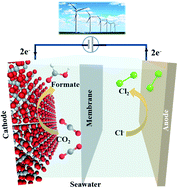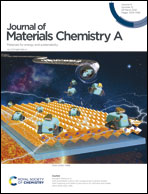Highly efficient CO2 electrolysis within a wide operation window using octahedral tin oxide single crystals†
Abstract
Electrocatalytic CO2 reduction is an effective way to close the global carbon cycle. Tin oxides have been demonstrated as promising catalysts to convert CO2 into formate with high selectivity but with low reactivity and within a narrow potential window. Herein, octahedral tin oxide (SnO2) single crystals have been well tuned and exhibited a high formate selectivity within a 500 mV wide operation range and a remarkable high formate partial current density of ∼500 mA cm−2. In situ Raman spectroscopy and DFT calculations indicate that high-energy facets of SnO2 favor the adsorption of *OCHO and the desorption of HCOOH*, which breaks the limitation of the scaling relationship of these intermediates on the (110) facet of conventional SnO2 nanoparticles and thus enhances formate selectivity. More interestingly, a maximum formate selectivity of 95% is achieved on SnO2 (111) due to the deeply suppressed hydrogen evolution in seawater. These catalysts have been further coupled with chlor-alkali electrolyzers to convert greenhouse gas CO2 into formate and produce higher-value Cl2 simultaneously. The present work will advance the development of practical CO2 electrolyzers.



 Please wait while we load your content...
Please wait while we load your content...